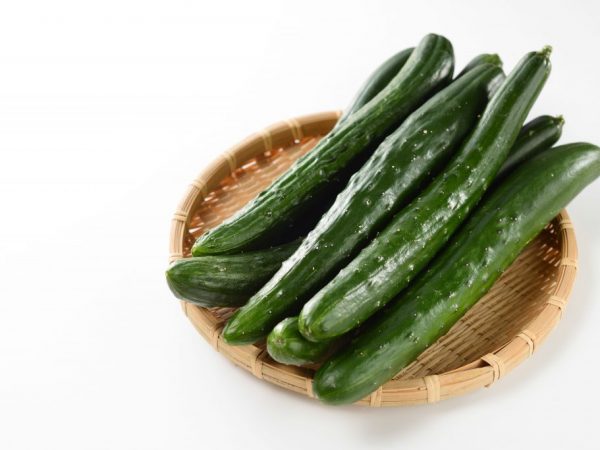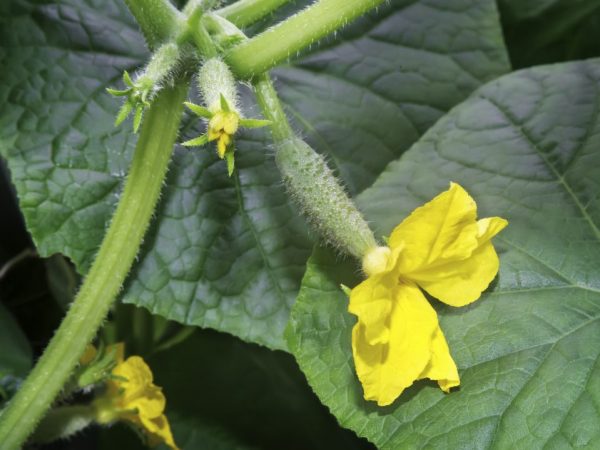Characteristics of Alligator cucumbers
Each new season in horticulture begins with the selection of crops and varieties for growing in the garden. Cucumbers are often included in the lists of selected crops. Sophisticated gardeners, and even beginners, are in search of new varieties that will not only be of high quality, but also surprise with their unusual shape or color, among which it is worth highlighting the Alligator variety of cucumbers.

Characteristics of Alligator cucumbers
Variety characteristics
The variety refers to it as fast-ripening - the fruit ripens in 40-45 days. Differs in high productivity. From 1 sq. M. about 16 kg of cucumbers can be harvested. Also note its resistance to various unfavorable changes in conditions. Suitable for growing in conventional greenhouses and open beds.
Description of the bush
Variety of indeterminate type, vigorous bushes with a well-developed root system. The uprightness is good, it can easily curl along the horizontal support. Medium leaves have a pentagonal shape with smoothed corners, uniformly green, slightly pubescent. A plant with a female flowering type, up to two fruits are formed in internodes.
Description of the fetus
Alligator cucumbers are often chosen for planting because of the unique shape of the fruit. Cucumbers of this variety grow up to 45 cm in length, but have a small circumference, weight on average 300g and more.
Fruit appearance:
- elongated cylindrical shape;
- the tuberosity is average;
- short spines in small numbers;
- the pulp is light, homogeneous;
- seeds are very small and elongated.
Alligator f1 cucumbers have a very high taste, they note a clear cucumber taste, juiciness and a slightly sweetish aftertaste. A variety for table purposes, used in salads and even in desserts.
Care
In order for the plants to develop well, and the fruits to be large, crispy and tasty, of the correct shape, even such an undemanding variety needs care and proper agricultural technology. In the cultivation of cucumbers, it is important not only to choose a variety, but also to plant, water, feed correctly, so that strong bushes will please with a high yield.
Landing

The plant needs good lighting
This variety can be grown both as seedlings and non-seedlings. If you grow cucumbers through seedlings, then the harvest can be obtained 1-2 weeks earlier than those sown directly into the ground.
- For seedlings, seeds are sown no earlier than the 20th of April, in loose disinfected soil. Peat pots are used, with them it will be possible to plant seedlings on the garden bed without injuring the root system.
- In open ground or in a greenhouse, seeds are sown when the soil temperature reaches 15 C. Cucumber seeds are deepened into the ground by 2-3 cm and well covered with soil. After sowing cucumbers in the open field, they can be covered with non-woven material or film.
The Alligator f1 cucumber bed must be well prepared.
Cucumbers love loose, well-drained soil, fertilized with mineral or organic fertilizers. The landing site should be well lit and ventilated. When planting bushes, the distance between the bushes must be 40x50 cm, per sq.m should be no more than two plants.
Watering
This Chinese hybrid is hygrophilous, and not only its growth, but also the quality of the fruit depends on watering. With insufficient watering, cucumbers grow small, irregularly shaped. The alligator should be watered with warm water, the temperature should not be lower than the soil temperature, and preferably 2-3 degrees higher. Watering is carried out in the morning at least once every two to three days. During the dry season every day. The bushes also react well to spraying on the leaf with warm water, this increases the humidity of the air and has a positive effect on the plant.
Top dressing
For good development, high yield and long-term fruiting, Alligator F1 cucumbers require foliar feeding several times during the growing season. It will be enough to carry out three such dressings.
- 14 days after planting the seedlings in the ground (three weeks after the emergence of seedlings.
- At the beginning of flowering. Feeding is done with phosphorus potassium fertilizers. You can use superphosphate, prepare the solution as follows: dissolve 30 g of fertilizer in 10 liters of water. The resulting solution is sprayed onto the plants.
- At the beginning of fruiting. Here again you will need nitrogen fertilizers, urea solution, in the same dosage as in the first feeding.
In organic farming, you can use ash, chicken manure to replenish nitrogen reserves, and bone meal or herbal infusion as a phosphorus-potassium supplement. It is important to maintain dosage with any kind of fertilizer.
Pests and diseases
In the description of the alligator cucumber variety, high resistance to powdery mildew, parasporosis, cucumber mosaic, anthracose is noted. But to improve resistance for preventive purposes, the bushes can be treated several times with Trichodermin.
But pests can infect the Alligator f1 variety:
- nematode;
- spider mite;
- aphid.
In the fight against aphids, insecticides of a wide spectrum Aktara, Komandor, Aktelik will help. From a spider mite, it will be necessary to carry out 2 treatments with acaricides (Fufanol, Fitovem, Antimite). To combat the nematode, you can use nematophagin - an environmentally friendly, natural, biological preparation based on the predatory fungus Arthobotrys oligospora.
Conclusions.
The variety is distinguished not only by the unique shape and good taste of the fruit, but also not picky about growing conditions and care. Disease resistance is undoubtedly a virtue of sotra. Watering and feeding will help you get a good harvest.


